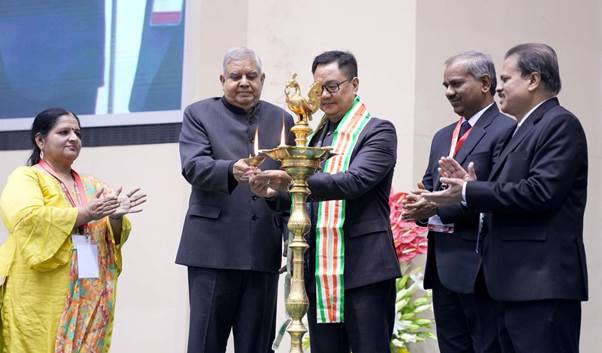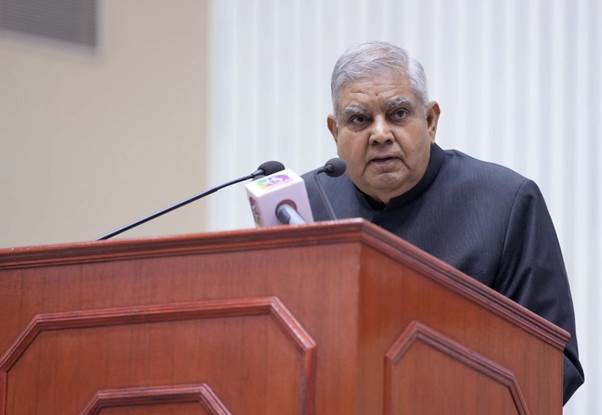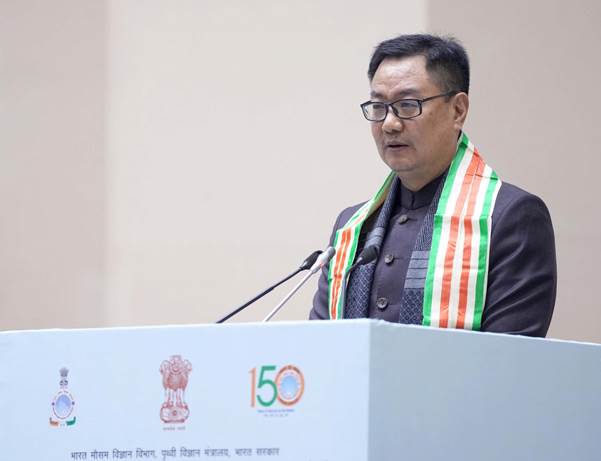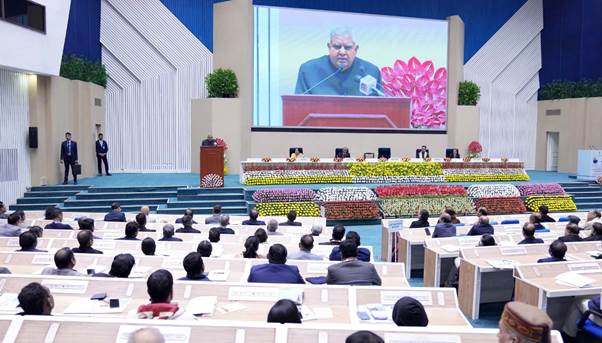India Meteorological Department celebrates 150th Year of its establishment and service to the nation
India Meteorological Department (IMD) celebrated 150th Year of its establishment and service to the nation today. The Vice President of India, Shri Jagdeep Dhankar graced the occasion as Chief Guest in the inaugural ceremony celebration of 150th years of its establishment. Shri Kiren Rijiju, Union Minister of Earth Sciences graced the occasion as Guest of Honour. Dr. M Ravichandran, Secretary MoES presided over the function. Former Secretaries of Ministry of Earth Sciences, former Director Generals of India Meteorological Department (IMD), Heads of various sister organisations in MoES, Secretaries of various Ministries, Chief Secretaries & Resident Commissioners of various States and Union Territories, Heads of various disaster management agencies, Heads of various Universities and institutions, employees of IMD, researchers & academicians and press & electronic media participated in the ceremony. Around 1,200 delegates countrywide participated in the event organised in New Delhi.

Vice President of India, in his address appreciated IMD for its valuable services to the nation and congratulated IMD for reaching this important milestone. He highlighted that the policy, plans and programmes of IMD are aligned with mainstream programmes of India and the vision & mission of Prime Minister and his team. He appreciated IMD for the pivotal role in increasing the farmer’s income through appropriate forecast of daily weather, hazards and crop weather advisories issued by IMD in collaboration with Ministry of Agriculture, state & central Agricultural Universities and the state Agricultural departments. Through accurate forecast, a BPL family farmer with a land holding of less than 2 acres in rainfed area gains Rs 12,500 by using weather information and the country gains 13,300 crores towards GDP per year.

To support Gati Shakti and Udaan Scheme, IMD has contributed significantly by ensuring safe aviation through Aviation Weather monitoring and forecasting for all 117 Airports. He appreciated the indigenous development of various instruments, software’s to improve the weather & climate services, including the decision support system and the mobile App launched today.
He also appreciated the early warning services provided by IMD during Super Cyclone Amphan in 2020 and cyclone MOCHA in 2023 for which IMD earned appreciation from WMO and United Nations and United Nations High Commissioner for Refugees (UNHCR). He also appreciated the accurate forecast during cyclone Biparjoy that enabled disaster managers achieve absolute zero loss of life in Gujarat. He also highlighted the role of IMD in economic development of the country through its services to each sector of society.
The release of Mausam Gram today is in line with the Government’s programme of “Sabka Saath Sabka Vikaas”. IMD is playing a pivotal role in providing Early warning to more than 90% population in the country. He also highlighted the services of IMD to Power & Renewable Energy Sector to minimse the losses and improve the economy, in line with Govt. of India Scheme “LIFE”. The National Framework of Climate Services launched today aims to maximise utilisation of climate information, as a part and parcel of all our activities, with special emphasis on disaster risk reduction, water, health, energy and agriculture management. He urged the countrymen, business & industries, farmers & fishermen, researchers & academia and all socio-economic stakeholders to utilise climate & weather information in all their activities including human & community, agricultural, health and industrial activities to ensure a “Weather Ready and Climate Smart India”.
He concluded his address with remarks that IMD must be prepared to adopt new technologies to enable India to emerge as Global leader for meteorological services. IMD is supporting India’s ethics of Vasudhav Kutumbakam by providing weather forecast services to various countries in South Asia, Southeast Asia, Middle east and many more.
Speaking on the occasion, Shri Kiren Rijiju congratulated IMD on this momentous occasion. He applauded the proactive measures taken by IMD to improve the weather observational network in the country in the last decade. For example, the number of Doppler radars in the country has increased from 15 in 2014 to 39 in 2023, and additional 25 radars will be added in the next 2-3 years. Rainfall Monitoring Stations have increased from 3,955 in 2014 to 6,095 in 2023; upper air stations have increased from 43 in 2014 to 56 in 2023; High wind speed recorders increased from 19 in 2014 to 35 in 2023. He also informed that total number of radars in the country will go upto 86 in next 5 years and events like cloudbursts will be predicted with sufficient lead time. He also expressed his gratitude to Prime Minister for the mega scheme PRITHVI that will enable the Ministry to take up new initiatives for further improving the services. In his address he highlighted that IMD has traversed with many successes and challenges and especially in recent decade, it has demonstrated its global leadership through scientific and technological innovations. He wished that IMD would continue its journey of progress, bring out new innovations and meet the requirement of people in the world. He congratulated all IMD employees and entire meteorological fraternity for achieving this milestone. He hoped that in this Amrit Kaal, IMD will reach out to every household and ensure scientific knowledge based information and guidance to have not only disaster resilience society, but also to be partner in 5 trillion dollar economy.

Earlier, Dr. Mrutyunjay Mohapatra, Director General of Meteorology, IMD, in his Welcome Address, discussed the evolution of meteorological services in the country since ancient era and the paradigm shift in all components of early warning system including the observations, communication, modelling, dissemination and services over the years. Commencing from Port Warnings in 1865, IMD came up with climate service in 1908, aviation meteorological service in 1911, ozone monitoring in 1928, agrometeorological service in 1945, positional astronomy in 1955, marine services & flood meteorological service in 1966, storm surge warning in 1977, Antarctica expedition in 1982, mountain weather service for Himalayas in 1998, Digitisation & automation in 2006 under modernisation programme of IMD, coastal inundation in 2013 in collaboration with INCOIS, air quality forecast in collaboration with IITM in 2018, impact based forecasting in 2019, urban meteorological services in 2020, GIS based applications in 2020 and many more.
Dr. Mohapatra, in his address, highlighted that IMD is ready to scale new heights and reach out to each and every household with weather information at anytime and anywhere “HAR HAR MAUSAM and HAR GHAR MAUSAM” with state-of-art technology and collaboration of academia, R & D institutes, public private partnership and stakeholders.
On the occasion, the Vice President Shri Jagdeep Dhankar released the Theme song of IMD. The theme song highlights the evolution and services provided by IMD for the country and the international community in the principle of “Sarvajan Hitay Sarvajan Sukhay” i.e. “Commitment to work for the Welfare of All”.

On the occasion of 150th year celebrations of IMD, the Vice President released and launched the following:
- Souvenir on Evolution of IMD and its services since 1875
The souvenir brings out evolution and achievements of organisational structure, observations, communication, modelling and services of IMD since 1875.
- Indigenously developed Decision Support System
The India Meteorological Department has developed the in-house Web-GIS-based integrated Decision Support System (DSS) known as the Weather Analysis and Forecast Enabling System (WAFES), inspired by Pancha Mahabhuta i.e. Water, Air, Fire, Earth and Sky. The WAFES serves as a visualization platform to analyze meteorological observations and prediction models, aiding decision-making for severe weather phenomena and their socio-economic impact. The DSS includes the Meteorological Information Communication System (MICS), Data Information Processing System (DIPS), Synthesized Integrated Visualization System (SIVS), and Public Weather Information System (PWIS). It incorporates specialized modules for severe weather events and utility tools for visualization, analysis, and response actions based on IMD’s early warnings. It provides real-time information for various sectors such as Urban, Power, Hydrology, Health, Energy, Agriculture, Transport and Tourism under the “UPHHEATT” initiative (for the cause of welfare).
- Panchayat Mausam Seva for farmers
India Meteorological Department, Ministry of Earth Sciences, Ministry of Panchayati Raj and Green Alert Mausam Sewa have jointly developed Panchayat Mausam Sewa Portal. Through this portal weather forecast in English, Hindi and twelve regional languages will be provided to every panchayat head and panchayat secretary to reach every village of the country. This initiative will enrich every farmer of the country with weather alerts, warnings, medium range weather forecast to help them in planning the agricultural activities like sowing, transplantation, application of irrigation, fertilizers, pesticides, etc. It will help in reducing the input cost and crop loss due to aberrant weather, and finally increase the production and income. The URL of the developed webpage is : https://mausam.imd.gov.in/greenalerts
- IMD’s Mobile App and Mausamgram
IMD launched an integrated GIS based interactive mobile app MAUSAM for all weather-related services like current weather, forecast of every hour to 7 days, Rainfall, Humidity, Sunrise/Sunset, Moonrise/Moonset, Rain Alert, Lightning Alert, Cyclone Alert, Aviation and Agro-Meteorological advisories. The app supports 12 Indian languages for varied users in India.
Upholding the vision “Har Har Mausam, Har Ghar Mausam,” IMD introduces “mausamgram,” available through the Mobile App “Mausam”. It allows the public to view observations, forecasts, and warnings for their location through a map or search function using place names, pincodes, or coordinates. Forecasts and warnings are disseminated in text and graphics format this mobile App. This platform empowers the common person to access detailed weather forecasts for their chosen location with a simple click on the map including the oceanic area. The forecasts are available on an hourly, 3-hourly, and 6-hourly basis upto next 10-days, covering crucial weather parameters such as rainfall, temperature, humidity, wind speed, and cloud cover. The module is developed indigenously within IMD using state-of-the-art tools and technologies, ensuring accuracy and reliability.
The “mausamgram” can be availed also through IMD Website (https://mausamgram.imd.gov.in).
- National Framework of Climate Services (NFCS)
Weather and Climate influence our lives and livelihood. Considering this, the India Meteorological Department introduces the National Framework of Climate Services (NFCS).
IMD prepares the climatology of basic meteorological parameters like rainfall, temperature, wind & pressure and the climate extremes like heat wave, cold wave, thunderstorm, cyclones, depression, lows, heavy rainfall etc. It is being updated every 10 years.
IMD has digitised all observational data since 1901. In 2021, the India Meteorological Department introduced a visualization tool for the public to observe different climate parameters, extremes, climate hazards and vulnerability maps for severe weather events.
IMD provides climate forecast for each month and season based on the dynamical multi model ensemble climate forecast system since 2021.
With all these developments climate services in the country multiplied with special emphasis on agriculture, hydrology, disaster risk reduction, health and energy.
While we have achieved significantly, we have to improve climate applications further with implementation of NFCS so as to enable each and every individual and organisation to be climate smart and hence improve the economy of the country.

